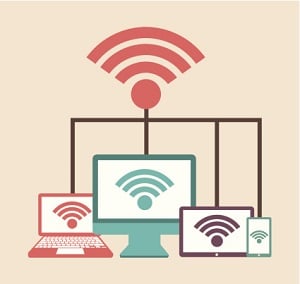 Today’s business environment relies upon constant connectivity. Your business can have the most advanced facilities or production equipment in the world, but without a telecommunications network to provide connectivity to the world around it, your business may struggle.
Today’s business environment relies upon constant connectivity. Your business can have the most advanced facilities or production equipment in the world, but without a telecommunications network to provide connectivity to the world around it, your business may struggle.
That said, telecommunications systems are easily taken for granted. Every day your employees come and go from the office with the assumption that when they want to make a call, access email, or conduct research online, they’ll be able to do so. How does all of this work? What does it take to manage and maintain these networks? Who is behind all of this? This guide offers an introduction to this necessary business network.
Telecommunications: What Is It?
Quite simply, telecommunications is any communication that takes place over a distance. Originally, telecommunications was as simple as installing phone lines and switchboards that allowed contact with clients and customers with a phone call. Today, telecommunications includes any communication over telephone, video conference, wireless networks, computer networks, and cellular networks.
What Is a Telecommunications Network?
A telecommunications network is a group of nodes and links that are connected for the purpose of transmitting information. Common telecommunications networks include:
- LANs
- WANs
- Radio
- PSTN Telephone Service
- Cellular Service
- Emergency Dispatch
- Ham Radio
- Broadcast Networks
Not familiar with some of these acronyms? Read on!
Key Telecommunication Terms
If you already thought the tech industry was frustrating for its fondness for acronyms and jargon, telecommunications takes it to a new level.
I’ve included some terms that you might hear if you’re discussing phone options with a provider. However, you shouldn’t have to commit these to memory in order to have a productive discussion. If you’re talking to a provider that isn’t able to speak to you in plain language about a solution, that’s their problem, not yours.
ACD (Automatic Call Distribution)
This feature distributes incoming calls to a representative, and also will typically include analytical tools. ACD is especially helpful for organizations that receive a high volume of calls.
ANI (Automatic Number Identification)
This feature is similar to caller ID, but while caller ID often identifies the main number of a business, ANI will identify the exact number someone is calling from.
Automated Attendant
Also called a virtual receptionist, this feature will help callers route themselves to the best destination within an organization. It’s hard to beat the human touch, but a virtual receptionist can help handle after-hours calls and handle multiple calls at the same time.
CSU (Channel Service Unit)
It sounds fancy, but a CSU is just a component that connects a digital line to a digital device.
DID (Direct Inward Dialing)
This feature allows callers outside an organization to reach an individual extension.
DOD (Direct Outward Dialing)
This feature allows users within an organization to place external calls using an access code.
IP (Internet Protocol)
IP is how one smart device sends data to another through the internet.
IVR (Interactive Voice Response)
IVR is that voice on the other end of the line that asks you for identifying information and the nature of your call before transferring you to an actual representative. Not every IVR experience is perfect, but when designed well, it can actually improve customer satisfaction and reduce hold times.
MPLS (Multiprotocol Label Switching)
MPLS is a networking technology that routes traffic using the shortest path instead of network addresses to forward calls over Wide Area Networks, or WANs.
PBX/PABX (Private Bank Exchange)
A telephone switching system usually installed at a business location as opposed to a service provider's central office.
PDN (Primary Directory Number)
The telephone number that the physical telephone set is associated with. Generally, this is the first telephone number that’s listed. SDN is less commonly used, but it stands for Secondary Directory Number.
POTS (Plain Old Telephone Service)
This is one of my favorites. If someone asks you if you are using copper POTS, they might be talking about your phone system and not your kitchen equipment.
PSTN (Public Switched Telephone Networks)
Another way of saying traditional telephone service. This system has been in use since the late 1800s.
SIP Trunking
Should you upgrade to hosted VoIP, your provider will use this technology to provide you with the same features that you’d get from your own on-premises PBX. SIP stands for Session Initiation Protocol, but it’s also known as elephant trunking.
SLA (Service Level Agreement)
If you use a third-party provider for telephone service (or other managed services, for that matter), you’ll sign a contract with them that spells out each party’s responsibilities. Within the telecommunications industry, your provider should indicate their guaranteed uptime, what will happen if things go wrong, and how they will keep your systems and data secure.
If your hosted voice provider doesn’t offer an SLA, proceed with caution, as you may not have much recourse for poor performance. It’s also important to pay attention to guaranteed uptime. 99.9% sounds great, but over the course of a year, that could mean over eight hours of downtime. 99.99% cuts it down to under an hour, and 99.999% reduces downtime to just a few minutes.
TCO (Total Cost of Ownership)
When you make an investment in any new system, it’s important to consider the total cost of ownership. Investing in your own, on-premises systems and tools is often cheaper in the long run, but in addition to the significant upfront investment, you’ll pay for their maintenance and upkeep and the additional staff you may need to support them.
Over time, an on-premises system may be cheaper, but you will probably have more unpleasant surprises than someone who chooses a managed service. Finally, a system managed in the cloud is typically the better option for organizations that have hybrid or remote staff.
Trunks
A collection of phone lines that are shared among multiple users.
VoIP (Voice Over Internet Protocol)
This technology uses an internet connection instead of traditional landlines to make and receive calls.
VPN (Virtual Private Network)
A VPN includes encryption that can help keep your IP address hidden from prying eyes, including cybercriminals.
WAN (Wide Area Network)
A WAN is a large information network that isn’t tied to one physical location. WANs can be global, whereas a LAN (Local Area Network) has a limited footprint.
Do You Still Need Telecommunications?
Unlike our acronyms and jargon, this answer is quite simple. Websites and chatbots can’t do everything, nor should they. Businesses are all about people, and connecting with other human beings in real-time will always be important.
Wouldn’t it be amazing if every company that said, “Your call is important to us,” acted like it? Phone calls are still important, and there are statistics to back this up. 77% of survey respondents believe a phone call is the most effective way to get an answer quickly; 30% of consumers say not being able to reach a human being is the most frustrating part of trying to resolve an issue; finally, 65% of people prefer to contact a business by phone over, for example, filling out an online form and waiting for a response.
What Does It Take To Manage Modern Business Networks?
Today’s telecommunications industry includes the devices you use to access data, the hardware that powers those devices, the software that processes information, and the fiber-optic and coaxial cables that transmit information.
Managing this telecommunication network requires knowledge and expertise to set up a system that works for your office and monitor its performance and activity. Maintaining these systems requires constant vigilance and the ability to perform software updates and repair or replace wired lines, servers, computers, and other devices that serve as the backbone and access point.
Leading Phone Carriers
AT&T used to be the dominant carrier in telecommunications. However, competition and consolidation (at times) have drastically changed the landscape. The evolving opportunities of telecommunication (beyond the phone to the internet and mobile data) have also created new players.
There are few providers today that specialize in just one area of telecommunications. For example, AT&T offers traditional telephone service, mobile data, and wireless voice coverage. Century Link offers fiber-optic Internet, nationwide MPLS networks, cloud-based voice and data services, and VoIP options. Today’s list of carriers includes, but is not limited to, CenturyLink, AT&T, Windstream, Level 3, Integra, Enventis, Zayo, Comcast, and Charter, to name a few.
Brief Intro to Carrier Services
Telecommunications and its required connectivity is an advanced field that often goes unmanaged within business environments. It’s a daunting task for companies of any size, but a worthwhile one.
A careful review of your services can help you determine if you’ve been overpaying, and if you’re using the best carrier for your organization. And get this — all you have to do to get started is connect with another human being.
